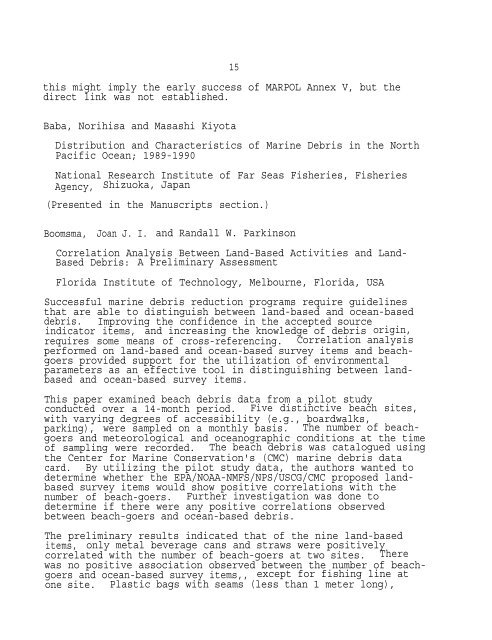Poster abstracts and manuscripts from the Third International ...
Poster abstracts and manuscripts from the Third International ...
Poster abstracts and manuscripts from the Third International ...
You also want an ePaper? Increase the reach of your titles
YUMPU automatically turns print PDFs into web optimized ePapers that Google loves.
this might imply <strong>the</strong> early success of MARPOL Annex V, but <strong>the</strong><br />
direct link was not established.<br />
Baba, Norihisa <strong>and</strong> Masashi Kiyota<br />
15<br />
Distribution <strong>and</strong> Characteristics of Marine Debris in <strong>the</strong> North<br />
Pacific Ocean; 1989-1990<br />
National Research Institute of Far Seas Fisheries, Fisheries<br />
Agency, Shizuoka, Japan<br />
(Presented in <strong>the</strong> Manuscripts section.)<br />
Boomsma, Joan J. I. <strong>and</strong> R<strong>and</strong>all W. Parkinson<br />
Correlation Analysis Between L<strong>and</strong>-Based Activities <strong>and</strong> L<strong>and</strong>-<br />
Based Debris: A Preliminary Assessment<br />
Florida Institute of Technology, Melbourne, Florida, USA<br />
Successful marine debris reduction programs require guidelines<br />
that are able to distinguish between l<strong>and</strong>-based <strong>and</strong> ocean-based<br />
debris. Improving <strong>the</strong> confidence in <strong>the</strong> accepted source<br />
indicator items, <strong>and</strong> increasing <strong>the</strong> knowledge of debris origin,<br />
requires some means of cross-referencing. Correlation analysis<br />
performed on l<strong>and</strong>-based <strong>and</strong> ocean-based survey items <strong>and</strong> beachgoers<br />
provided support for <strong>the</strong> utilization of environmental<br />
parameters as an effective tool in distinguishing between l<strong>and</strong>based<br />
<strong>and</strong> ocean-based survey items.<br />
This paper examined beach debris data <strong>from</strong> a pilot study<br />
conducted over a 14-month period. Five distinctive beach sites,<br />
with varying degrees of accessibility (e.g., boardwalks,<br />
parking), were sampled on a monthly basis. The number of beachgoers<br />
<strong>and</strong> meteorological <strong>and</strong> oceanographic conditions at <strong>the</strong> time<br />
of sampling were recorded. The beach debris was catalogued using<br />
<strong>the</strong> Center for Marine Conservation's (CMC) marine debris data<br />
card. By utilizing <strong>the</strong> pilot study data, <strong>the</strong> authors wanted to<br />
determine whe<strong>the</strong>r <strong>the</strong> EPA/NOAA-NMFS/NPS/USCG/CMC proposed l<strong>and</strong>based<br />
survey items would show positive correlations with <strong>the</strong><br />
number of beach-goers. Fur<strong>the</strong>r investigation was done to<br />
determine if <strong>the</strong>re were any positive correlations observed<br />
between beach-goers <strong>and</strong> ocean-based debris.<br />
The preliminary results indicated that of <strong>the</strong> nine l<strong>and</strong>-based<br />
items, only metal beverage cans <strong>and</strong> straws were positively<br />
correlated with <strong>the</strong> number of beach-goers at two sites. There<br />
was no positive association observed between <strong>the</strong> number of beachgoers<br />
<strong>and</strong> ocean-based survey items,, except for fishing line at<br />
one site. Plastic bags with seams (less than 1 meter long),
















